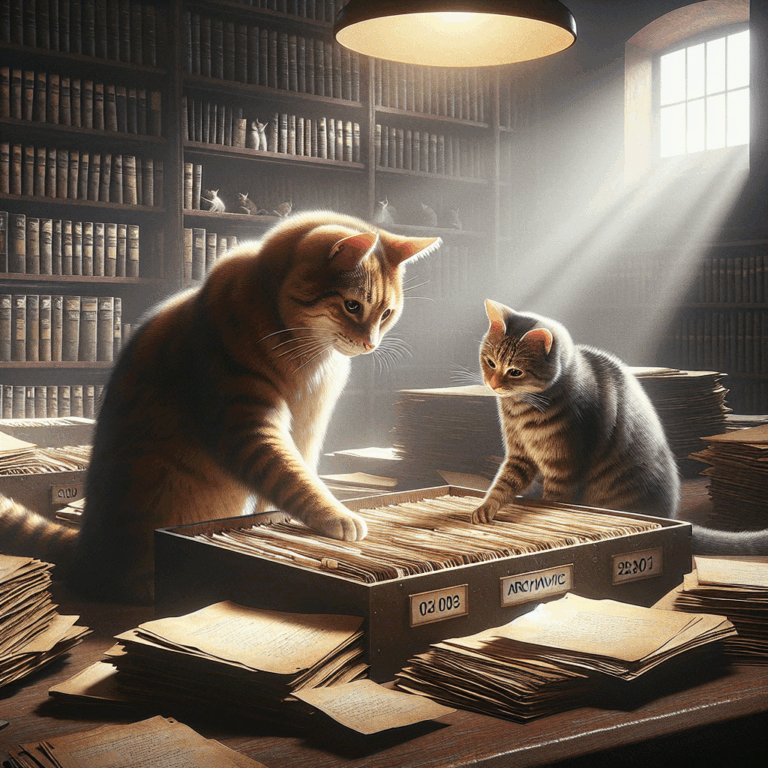The Feline Innovators of Historical Preservation: Cats and Their Role in Archival Conservation
- No Comments
In a surprising twist of fate, cats are rapidly emerging as unlikely allies in the world of historical preservation and archival conservation. While their traditional roles have been largely domestic, their presence is now being recognized in the meticulous world of document and artifact preservation. This newfound appreciation for our feline companions is rooted in their natural instincts and behaviors that inadvertently contribute to the safeguarding of our historical treasures.
Cats have long been revered for their ability to control and deter pest populations, a trait that finds its origins in ancient civilizations where they were worshiped as divine protectors of grain stores. This same instinct is now being harnessed in libraries, museums, and archives around the world, where cats are employed as natural pest control agents. Their keen sense of smell and agile hunting capabilities make them formidable opponents against rodents and insects that threaten to damage valuable manuscripts, artifacts, and other historical items.
One notable example of cats in historical preservation is the Hermitage Museum in St. Petersburg, Russia. For centuries, the museum has maintained a robust population of resident cats, affectionately known as the “Hermitage Cats,” who patrol the vast corridors and storerooms, keeping the premises free from vermin. This practice has been so successful that the museum has even adopted official policies to ensure the health and well-being of these feline guardians, recognizing their indispensable role in protecting the museum’s invaluable collections.
Beyond their pest control abilities, the quiet and unobtrusive nature of cats makes them ideal companions in the often hushed environments of archives and libraries. Unlike traditional methods of pest control, which can sometimes introduce harmful chemicals or disrupt the integrity of fragile items, cats provide an eco-friendly and non-invasive solution. Their presence is a testament to the harmonious balance between preserving history and respecting the natural environment.
Furthermore, the presence of cats in these environments is believed to have a positive impact on the mental well-being of staff and visitors alike. The calming presence of a friendly feline can reduce stress and create a more inviting atmosphere, encouraging a deeper appreciation for the cultural and historical significance of the materials being preserved.
As institutions become more aware of the benefits of incorporating cats into their preservation strategies, there is a growing movement to formalize their roles within the conservation community. Workshops and training programs are being developed to educate archivists and museum staff on best practices for integrating cats into their preservation efforts, ensuring that these feline conservators are able to perform their duties effectively and humanely.
In conclusion, the partnership between cats and archival conservation is a testament to the enduring bond between humans and animals. As we continue to explore innovative ways to protect our shared cultural heritage, the humble house cat emerges as an unexpected yet invaluable ally, combining centuries-old instincts with modern conservation techniques to safeguard the stories of our past for future generations. The world of historical preservation owes a debt of gratitude to these silent sentinels, whose quiet vigilance ensures that the treasures of yesterday remain intact for the scholars and dreamers of tomorrow.

In a surprising twist of fate, cats are rapidly emerging as unlikely allies in the world of historical preservation and archival conservation. While their traditional roles have been largely domestic, their presence is now being recognized in the meticulous world of document and artifact preservation. This newfound appreciation for our feline companions is rooted in their natural instincts and behaviors that inadvertently contribute to the safeguarding of our historical treasures.
Cats have long been revered for their ability to control and deter pest populations, a trait that finds its origins in ancient civilizations where they were worshiped as divine protectors of grain stores. This same instinct is now being harnessed in libraries, museums, and archives around the world, where cats are employed as natural pest control agents. Their keen sense of smell and agile hunting capabilities make them formidable opponents against rodents and insects that threaten to damage valuable manuscripts, artifacts, and other historical items.
One notable example of cats in historical preservation is the Hermitage Museum in St. Petersburg, Russia. For centuries, the museum has maintained a robust population of resident cats, affectionately known as the “Hermitage Cats,” who patrol the vast corridors and storerooms, keeping the premises free from vermin. This practice has been so successful that the museum has even adopted official policies to ensure the health and well-being of these feline guardians, recognizing their indispensable role in protecting the museum’s invaluable collections.
Beyond their pest control abilities, the quiet and unobtrusive nature of cats makes them ideal companions in the often hushed environments of archives and libraries. Unlike traditional methods of pest control, which can sometimes introduce harmful chemicals or disrupt the integrity of fragile items, cats provide an eco-friendly and non-invasive solution. Their presence is a testament to the harmonious balance between preserving history and respecting the natural environment.
Furthermore, the presence of cats in these environments is believed to have a positive impact on the mental well-being of staff and visitors alike. The calming presence of a friendly feline can reduce stress and create a more inviting atmosphere, encouraging a deeper appreciation for the cultural and historical significance of the materials being preserved.
As institutions become more aware of the benefits of incorporating cats into their preservation strategies, there is a growing movement to formalize their roles within the conservation community. Workshops and training programs are being developed to educate archivists and museum staff on best practices for integrating cats into their preservation efforts, ensuring that these feline conservators are able to perform their duties effectively and humanely.
In conclusion, the partnership between cats and archival conservation is a testament to the enduring bond between humans and animals. As we continue to explore innovative ways to protect our shared cultural heritage, the humble house cat emerges as an unexpected yet invaluable ally, combining centuries-old instincts with modern conservation techniques to safeguard the stories of our past for future generations. The world of historical preservation owes a debt of gratitude to these silent sentinels, whose quiet vigilance ensures that the treasures of yesterday remain intact for the scholars and dreamers of tomorrow.


